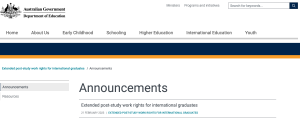
Story Topic and Angle
The National Kills Commission (NSC), a branch of the Australian Government that analyses the labour market, pointed out in a report that social workers, educators, nursing, and other professional workers have been in a state of shortage for nearly a decade. The COVID-19 pandemic is one of the significant reasons for exacerbating the substantial shortage of these positions. Through 2026, some of these shortage industries are expected to account for the majority of total employment growth, up to two-thirds. In order to avoid unbalanced labour market forces, the Australian Government is preparing to implement a policy on July 1, 2023: extending the right of international graduates to work after graduation. It refers to an additional two years of work entitlement for eligible graduates and an additional eight-hour work-per-fortnight limit.
This article will be based on this policy and take students as the protagonists, reporting on how it affects students’ choice of majors, employment direction, and other aspects. Moreover, combine the interviews with exploring whether this measure can effectively solve the job shortage problem; if it does, it will solve the problem in the short or long term.

(A screenshot of the Announcement from the Australian Government)
News value
Impact & Proximity: This is relevant to the Australian education industry and employment society.
Timeliness: The Australian Government announced the policy in February 2023, and it will be officially implemented in July 2023. This is an ongoing concern as the policy is about to be implemented.
Publication and Target User Group
I will publish the story on ABC NEWS, Australia’s largest media organisation because it is authoritative with a particular world influence.
The target audience for this report is local students, international students and related companies in job shortage industries. As far as local Australian students are concerned, implementing this policy means there is less competition for employment in popular industries. In terms of international students, this may affect their primary choice and future employment direction.
Detailed sources of information
Interviewee:
A ready-to-graduate international student whose major is in Nursing.
A Chinese student preparing to apply to a university to study abroad.
A principal of an early childhood education school.
Source
Policy documents published by the Australian Government
Documents of employment outlook and employment data files released by the National Kills Commission (NSC)
Multimedia, Hypertext and Interactivity
Multimedia: Relevant news report videos about the release of this policy and screenshots of documents about statements and employment data will be inserted in the report.
Hypertext: The official keywords will be set as a hypertext of related documents, so readers can click the link and browse for more specific policies and statement details. The keywords related to international students will be a hypertext of the reports published by some foreign-related institutions. This allows readers to understand other countries’ attitudes toward this policy quickly.
Interactivity: Readers can use the comments section after clicking on a hyperlink to a social media page, such as the Australian Government

It’s a news topic that I also follow very closely, and I think it’s a real time issue for Australian society right now. You reinforce the credibility of the article by citing data and expert opinion to support their argument and by acknowledging the potential shortcomings of the proposal. This will also make your web interface look attractive to read.
However, this article has room for improvement in the sources of information and publications. The information source is too simple and the purpose is too clear. Some information sources at the social level can be added, such as the elderly in need of care, overseas students and ordinary Australian citizens, so as to provide a more comprehensive view of the article. Have you considered more social media in your publications? For example, Twitter and some social media that overseas students pay more attention to, although ABC NEWS is one of the most mainstream media in Australia, its main audience is not students. Concluding with more specific examples and case studies would also help to illustrate the potential benefits and drawbacks of the proposal and provide a more balanced view.